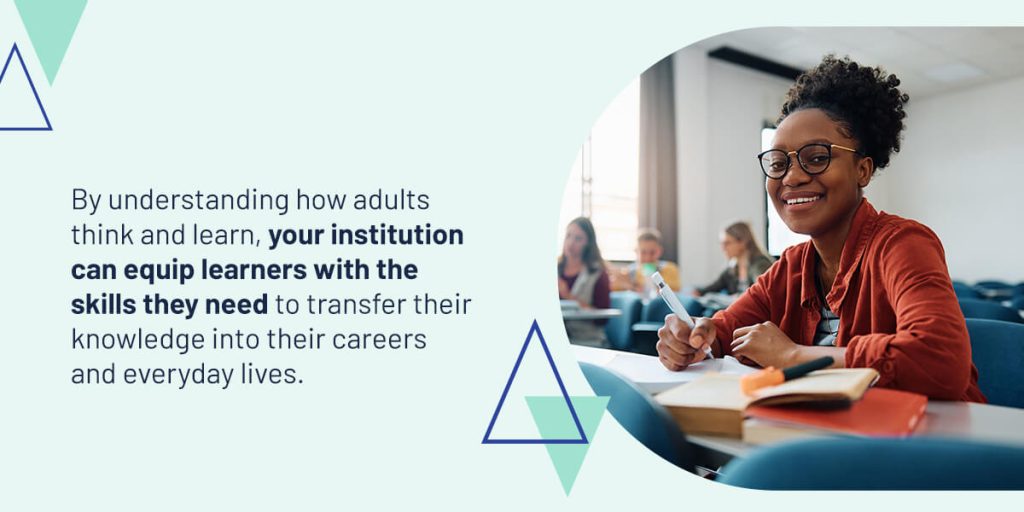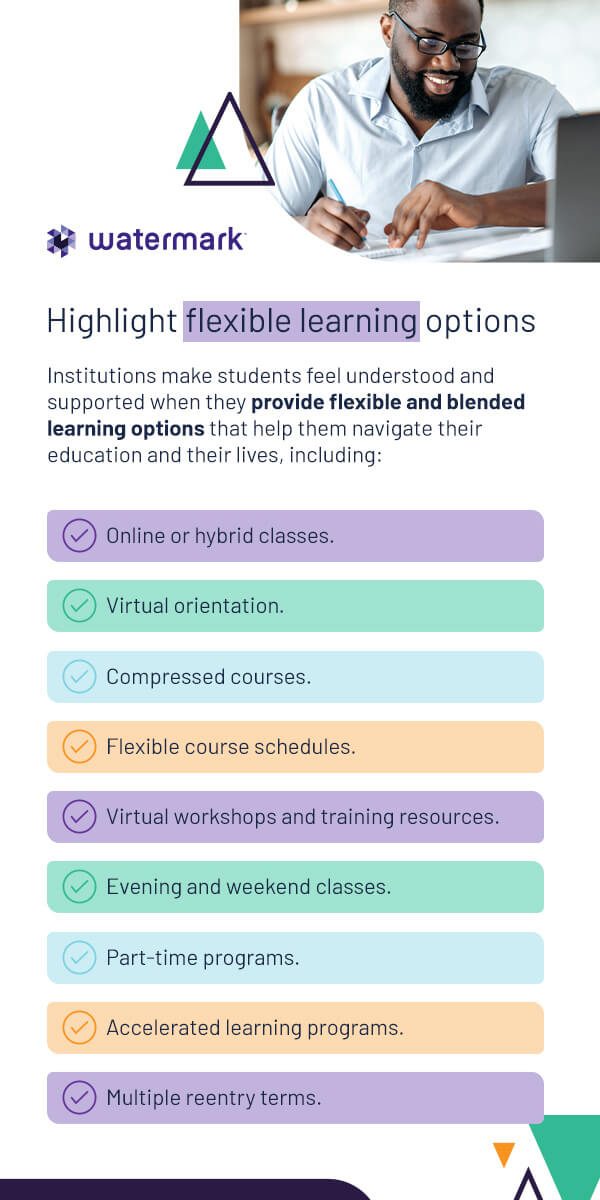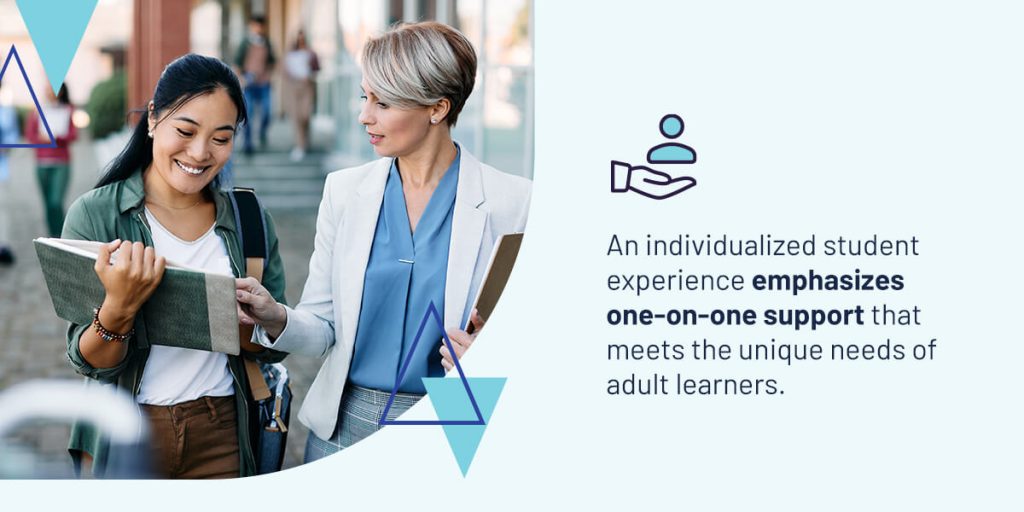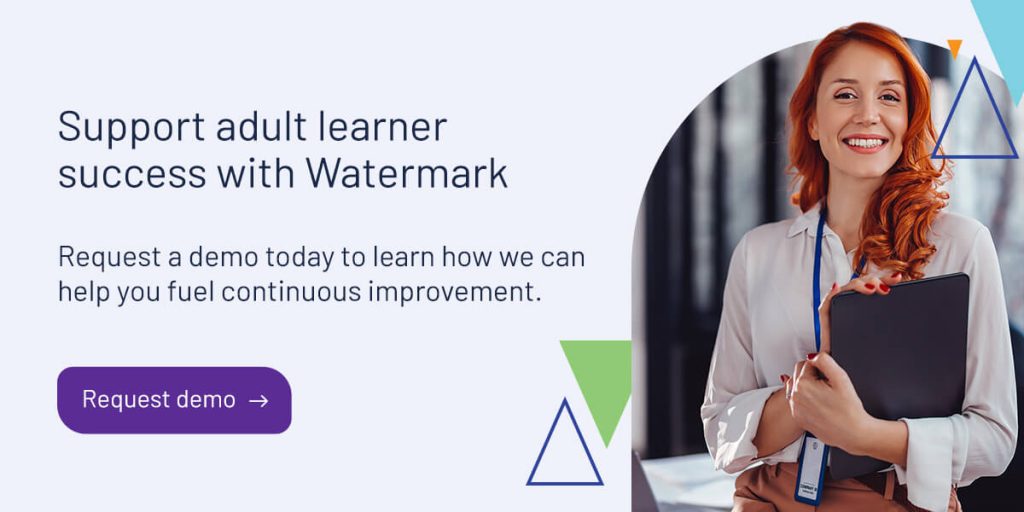




Financial pressures, work demands, family responsibilities, and motivational factors can all contribute to higher dropout rates for adult learners. Balancing educational and personal commitments becomes even more challenging when institutions lack the tools needed to encourage degree completion.
As an administrator at a higher education institution, you play a vital role in your student’s success. Integrating adult learning theory into your institutional improvement efforts can help you better support the unique needs of adult learners. Below, we’ll explore the principles behind adult learning theory and best practices for improving adult learner engagement and retention.
There’s plenty of research about how children learn and absorb information — but what about adults? Returning students have unique motivations, experiences, and responsibilities that require nuanced adult learning strategies. A one-size-fits-all approach may not be relevant and engaging for these individuals.
Pedagogy, the principles and methods used to teach children, differs widely from andragogy, the science of teaching adults and helping them learn. These distinct terms highlight that adults don’t necessarily process and retain information in the same manner as children.
Here are the six andragogical principles developed by Malcolm Knowles that can help your institution develop an effective framework for adult learning success:
Adult learning theory plays a key role in educational and professional development. It’s an essential resource for educators and academic organizations that want to understand and accommodate the learning needs of adults.

Higher education institutions may also support adult learner success by tapping into real world contexts. By understanding how adults think and learn, your institution can equip learners with the skills they need to transfer their knowledge into their careers and everyday lives.
A commitment to continuous improvement strengthens your position as a steward of adult student success. We believe these tips and strategies can help you apply adult learning theory and guide your students to achieving their goals.
While some adult learners may go through the traditional recruitment process, many already have some college credits or experience. Regardless, if they didn’t complete their degree, they had a reason — which is important to keep in mind. Going the extra mile to understand adult learners and recognize the barriers they face to graduating can make all the difference.
Every student has unique concerns, accomplishments and experiences. Institutions would do well to interact with them on this front and develop deliberate efforts to understand their needs.
Adult learners are at greater risk of dropping out of school due to a lack of financial and academic support. Given that adult learners often have more financial responsibilities, communicating your institution’s financial assistance can ultimately lead to greater retention rates. Whether or not your institution can offer major financial incentives to adult learners, it’s important to advertise how your organization alleviates financial burdens for adults, such as:
Many adult learners likely have previous work experience or are balancing their education while working simultaneously. This means institutions must tailor career and academic advising to specific career paths. High-quality advising services can help adult learners make informed decisions about their future and better understand the specific skills they will gain from their program. Your institution can make adult students feel more committed to their degree with services like:
The path to degree completion is a rewarding yet challenging experience for many learners. You can guide adult students to success by helping them focus on the end from the very beginning. From the moment they enroll, every student should receive support in identifying specific end goals for their education.
Communicate with students, show them the progress they’ve made, and address their concerns. For instance, an adult student who feels discouraged may feel supported by working with their advisor to maximize their schedule’s efficiency and build achievable goals.
Adult learners juggle many obligations and responsibilities in addition to classes. Childcare, eldercare, work, and social commitments can take up significant time in their week, making it challenging to stay focused. Institutions can actively help students learn time management skills by acknowledging the demands they face and offering assistance. Your administration can go a long way by sharing resources that help them learn how to develop a balanced schedule and manage their time effectively.
Flexible scheduling options can make all the difference for adult learners with busy schedules. It’s not always realistic for adult students to fit their lives into a traditional academic calendar. When class schedules conflict with family priorities and work responsibilities, students may feel discouraged to continue on their adult learning path. Institutions make students feel understood and supported when they provide flexible and blended learning options that help them navigate their education and their lives, including:

Advisors, professors, and administrators need to be in the loop when students face obstacles. Using assistive tools designed for student success, your institution can implement alerts and notifications that help staff prioritize adult learners who need immediate assistance.
When your staff is better equipped to monitor student attendance and academic progress, they can proactively support the success and retention of all adult learners. Additionally, streamlining administrative tasks saves staff members valuable time throughout the day, allowing them to focus on connecting students with the right institutional resources.
The decision to go back to school or complete a degree can be intimidating for some adult learners. It’s imperative that your higher education institution makes adult students feel welcome by easing the transition. Adult learners already have a lot on their plate — the last thing they need is to attempt to navigate an overwhelming admissions process. When adult learners are thinking about reenrolling in classes and land on your website, your messaging will quickly signify whether your institution is a good fit.
For instance, does your institution have a readmission page? Do you use messaging to specifically welcome adult and nontraditional learners? Will potential returning students feel guided through the admission process?
Easing the readmissions process is a great first step — but don’t stop there! Establishing flexible admission policies creates the perfect opportunity to reevaluate your enrollment, registration, and onboarding processes. Adult learners want to choose an institution that empowers them to finish their degrees.
Credits for prior learning (CPL), gathering transcripts, and recognized industry-validated certifications can encourage learners to retain college completion. Make your first impression count by lifting these barriers to entry and setting the stage for long-term success!
Adult learners expect some degree of balance between academic standards and career practicality, even those who have no specific career goals. As noted in the six andragogical principles above, adult learners want to know how they can apply their curriculum to the labor market after graduation. Institutions can implement these changes by:
Offering supportive services to adult students can yield little results when it’s too late. Early intervention is critical to keeping adult students motivated and encouraged to complete their academic path. With student success tools, your institution can collect and analyze student data and make informed intervention decisions.
Identifying struggling students early makes it easier for your administration to provide the targeted support they need, such as tutoring, peer mentoring, or mental health services. Whether adult learners face financial, academic, or personal obstacles, your administration can prevent students from falling behind and dropping out by addressing their unique needs.
Student engagement and retention is a collaborative effort. All faculty, staff members, administrators and adjunct instructors play a unique role in supporting each student on the path to success. While individual responsibilities can vary, a “whole-school” effort can support engaged learning and more effectively address student concerns. A team approach can also make adult learners feel understood and valued by your institution.
To improve institutional-wide collaboration, consider giving faculty and staff access to professional development opportunities. A commitment to ongoing learning and improvement on a staff and faculty level can contribute to a culture of learning and collaboration. For example, you might cross-train professional advisors, faculty advisors, and student service staff. Having your professionals train each other in strategies specifically designed to help adult learners expands your institution’s ability to create solutions to their obstacles.
A one-size-fits-all approach to higher education leaves little room for nuance. You can help set your institution apart by recognizing adult and nontraditional learners are more than a number in your program. Prioritize building genuine professional connections with adult learners by making every interaction personal.

For instance, an adult learner is much more likely to feel connected to faculty that remember unique aspects of their lives, goals, and professional achievements. An individualized student experience emphasizes one-on-one support that meets the unique needs of adult learners.
Your institution can foster a supportive community by encouraging adult learners to participate in campus life. Regardless of their educational or professional experience, all learners deserve to build connections and get involved with peers. This sentiment is particularly important for combatting the assumptions that adult learners are too old or too busy to engage in campus activities. Adult learners can receive the same benefits of social involvement after readmission as traditional learners straight out of high school.
Consider establishing opportunities unique to working adults and nontraditional learners that help them feel connected to your institution:
Poor communication can significantly impact student motivation. Institutions cannot effectively meet each adult learner’s needs if students struggle to get in touch with teachers, advisors, and other staff. All learners deserve transparency about their academic journey. However, keeping students informed is an obligation many institutions fail to meet. Your institution is responsible for empowering and engaging students by communicating with them and addressing their questions and concerns.
Administrators, instructors, advisors, and professors should check in with their students at scheduled points throughout the term to ensure they’re adjusting properly and feel supported in the courses. Establishing effective communication creates an atmosphere of transparency, making it easier for adult learners to get the critical information they need to succeed.
Feedback is an incredibly valuable tool that benefits your students, faculty, and the entire administration. If your institution wants to bolster student success and retention rates, it can be helpful to go right to the source. Collect feedback directly from students and staff to learn exactly what your institution can do to support engagement and degree completion. This feedback will offer explicit insights into the services and programs that are working well and the ones that need improvement.
Entice students to fill out surveys, send in comments, or respond to an open forum tailored to their unique experiences and needs as adult learners. This strategy will enable your administration to properly allocate resources and retention efforts where they’re needed most.
You can streamline your efforts to improve the adult learner experience with student success software. Technology-based retention solutions, including predictive analytics tools, enable your institution to:
By leveraging a student support system with these capabilities, you can cultivate actionable steps to improving student retention.
The challenges of adult learner engagement and retention continue to evolve. With these best practices, your higher education institution can welcome this unique population of students and facilitate their transitions. Consider leveraging the power of data to better support student success.
At Watermark, it’s our mission to help higher education institutions enhance student outcomes by flagging disengagement and employing data-driven insights. Watermark Student Success & Engagement solution is a unified platform that enables a holistic view of each student’s journey. Guided student pathways allow you to monitor student progress and implement proactive support for adult learners. Request a demo today to learn how we can help you fuel continuous improvement.































































































































































































































































































































































































Submit this form to schedule a meeting with one of our reps to learn more about our solutions. If you need customer support instead, click here.